The MacBook Pro Review (13 & 15-inch): 2011 Brings Sandy Bridge
by Anand Lal Shimpi, Brian Klug & Vivek Gowri on March 10, 2011 4:17 PM EST- Posted in
- Laptops
- Mac
- Apple
- Intel
- MacBook Pro
- Sandy Bridge
Thermals and Power Consumption
The new MacBook Pros have the potential to draw more power than the previous generation. Despite being built on a 32nm process, the new 15 has twice the cores of last year's model—there's no question that it can draw more power under a full load.
I measured maximum power consumption at the wall using the same power brick and a fully charged battery. I chose two high-load scenarios: Cinebench 11.5 and Half Life 2. The former will fully load all CPU cores while the latter ramps up CPU and GPU usage.
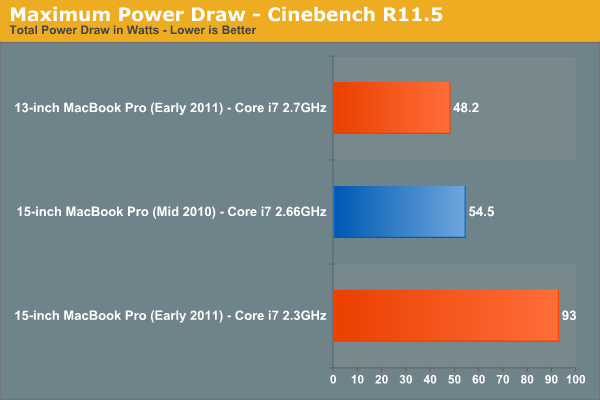
Under Cinebench the new quad-core 15-inch MacBook Pro draws 70% more power at the wall than last year's dual-core model. This shouldn't be surprising as Cinebench scales nearly perfectly with core count—twice the cores should result in nearly twice the power draw. The scaling isn't perfect since we are dealing with different architectures and a number of factors such as display remain static. The new 13-inch MacBook Pro isn't as worrisome, it has 88% of the power usage of the high end 2010 15-inch MBP and 81% of the battery capacity.
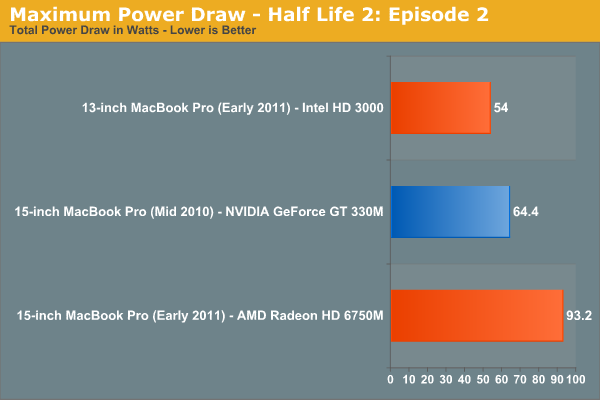
The Half Life 2 comparison is not quite as bad, although the new 15-inch MBP still uses 45% more power under full load compared to the previous generation. These numbers tell you one thing: although the new MBP is significantly faster than its predecessor, it can also draw significantly more power. Running the same workload the new MBP shouldn't have any problems lasting as long as the old MBP on battery, but running a more aggressive workload will result in shorter battery life as a result of the higher max power consumption. In other words if you use the higher performance to do more, you can expect your battery to last proportionally less than the 2010 MBP.

The 15-inch MBP uses an 85W power adapter (left) and the 13-inch MBP uses a 60W adapter (right)
Drawing more power also has another unfortunate side effect: the bottom of the chassis gets even hotter than before. I took some crude temperature measurements when I did the 2010 MacBook Pro reviews last year. I pointed an IR thermometer at the center of the bottom of the notebook, right where you'd have your lap, and measured surface temperature in a couple of scenarios.
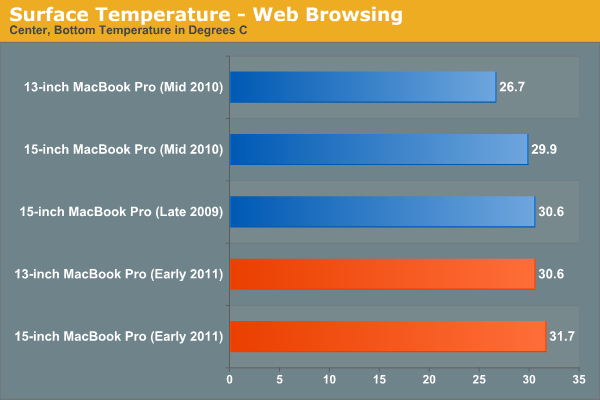
While browsing the web with tons of windows/tabs open I noticed a small but tangible increase in surface temperature of the 2011 15-inch MBP compared to the 2010 model. Even the new 13 is warmer than last year's 15. Under light workloads none of these temperatures are high enough to really be a problem.
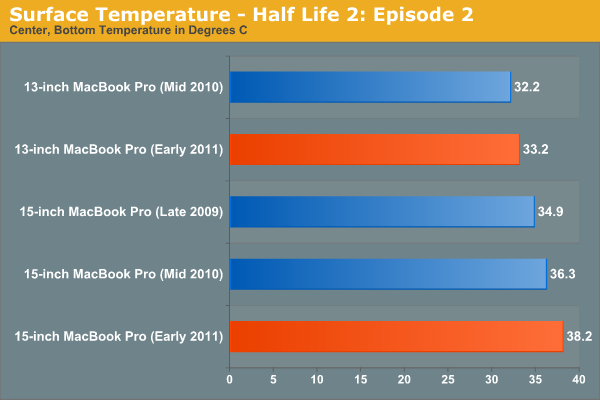
Load up the system however and you start getting into the uncomfortable zone. The new 15 breaks 38C, while the new 13 is actually only marginally warmer than the old 13 thanks to the use of Intel's HD Graphics 3000.
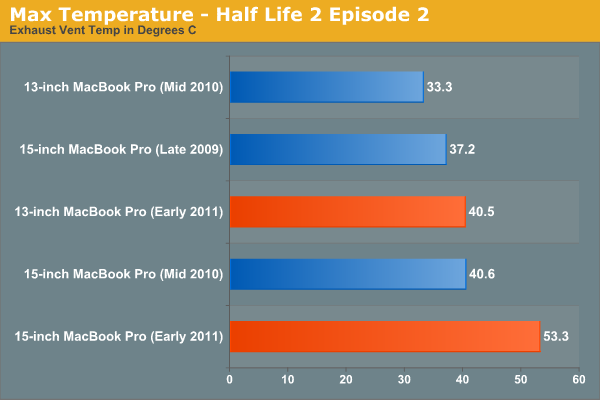
The biggest difference I noticed was the max temperature near the exhaust fan(s) on the notebooks. The new 15 is a whole 13C warmer than last year's model.
There's no way to get around it—if you're going to be using these systems to anywhere near their potential, they are going to get significantly warmer than last year's. Also, as a result, the new systems are noisier. Fans are more likely to spin up and given how small they are, they are quite audible. If this is a deal breaker for you, the best advice I can give you is to wait for Ivy Bridge.

Ivy Bridge will bring mild updates to the Sandy Bridge architecture, an increase in performance but more importantly it'll bring Intel's 22nm process. At 22nm I'd expect somewhat lower power usage than what we're seeing here today. Ivy Bridge is expected to ship in the first half of 2012, with updated MacBook Pros arriving ~2 months post introduction.










198 Comments
View All Comments
Anand Lal Shimpi - Friday, March 11, 2011 - link
Our top picks right now are either the Intel SSD 510 or something based on the SF-1200 controller (e.g. Corsair Force, OCZ Vertex 2). In the next month or so we should see the first wave of SF-2200 drives hit the market (e.g. OCZ Vertex 3). These things should scream. Keep an eye on our Storage section for new drives as we review them:http://www.anandtech.com/tag/storage
Take care,
Anand
phoible_123 - Thursday, March 10, 2011 - link
I purchased the low-end 13" the day it was released, and am super happy with it. I had been waiting for a while for a suitable upgrade to my 2007 White Macbook. I considered getting the last 15" (almost bought it), but I was worried about heat, size, and weight. Turns out that these concerns were justified, but the Sandy Bridge models seem to be much better.The performance of the new 13" is comparable to the old high-end 15". It is noticeably faster than the last-gen 13" (I have one of those at work). I don't really play games on my laptop, so I don't care about graphics (I have a desktop with a GTX460 at home hooked up to my HDTV).
I have played with all of the other laptops, and the build quality on the Macbook is just better than anything else I've seen. No question about it. Every time someone raves about some other laptop, I go to Best Buy and play with it, and I'm always disappointed (usually the keyboard and/or trackpad sucks, or the case is too flexy).
Sure, I could get a faster laptop for less money, but it wouldn't be as good at what i actually use it for (mostly software development). I got the low-end 13", and will use the money I saved to buy an Optibay and 128GB SSD (already upgraded the RAM to 8GB). The only laptop that could potentially beat it is the forthcoming MBA.
kigoi - Thursday, March 10, 2011 - link
ah except for when i bought it this is how it's gone for me too. and except for waiting to max memory if usage needs it. and maybe hoping for a slicker hybrid hard drive solution, something like the momentus xt but with more cache and a variable spindle.i wonder if the i5 model runs cooler than the i7. we stressed it with handbrake, experienced the fan, felt the underside. it didn't seem to get intolerably hot underneath unless there was zero airflow (like, on a bedcover).
oh btw here is a document of the hidden keyboard secrets of the fn key.
http://pludk.wordpress.com/2011/03/08/happy-accide...
kigoi - Friday, March 11, 2011 - link
oops error. the return of the hidden keypad was actually done by a software extension w/o my knowing. pretty thrilling to report that though, while it lasted.kanaka - Thursday, March 10, 2011 - link
I got my 15" AG yesterday and one of the first things i was impressed with was how sturdier the hing was compared to my existing Late 08 model.owbert - Thursday, March 10, 2011 - link
what is the trade offs between high res antiglare option and high (glossy) res display?kanaka - Thursday, March 10, 2011 - link
Glare vs no glare. Also colours are more saturated on the glossy screen. There's also a slight weight difference due to the glass vs no glass situation.mino - Thursday, March 10, 2011 - link
Simple: you trade "Bling!" for usability.gstrickler - Thursday, March 10, 2011 - link
More brightness and color saturation on the glossy screen, but more money better color accuracy, reduced glare, and slightly lower wright on the matte screen. The matte screen is also higher resolution than the standard screen, but you can get the hires screen in glossy or matte.One side benefit of the matte screen, in environments where glare may be a problem on the glossy screen (e.g. The Apple Store, many offices, etc), I find it's necessary to turn up the screen brightness on the glossy to overpower the glare. With the matte screen, I can use a lower screen brightness, which means less power, and better battery life. I'm not sure how much difference since I don't have a MBP with a glossy screen to perform a side by side test, but I estimate it at 15-30 mins.
dwade123 - Thursday, March 10, 2011 - link
The new Sony S is better.